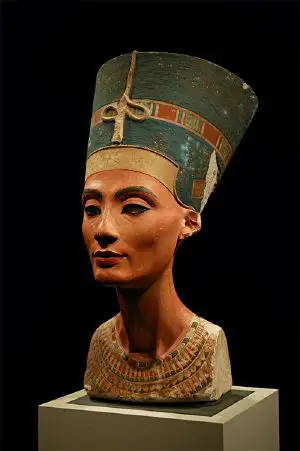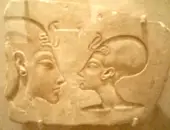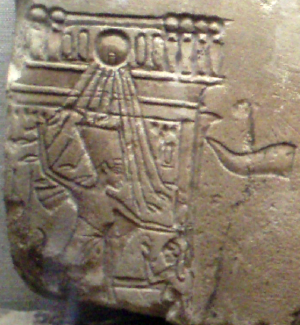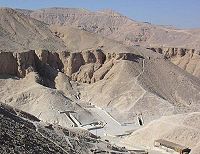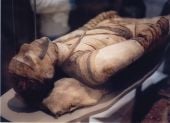Nefertiti
| Nefertiti in hieroglyphs | ||||||||||||||||
|
Nefertiti (pronounced at the time something like *nafratiːta) (c. 1370 B.C.E. - c. 1330 B.C.E.) was the Great Royal Wife (or chief consort/wife) of the Egyptian Pharaoh Akhenaten (formerly Amenhotep IV; reigned c. 1353–36 B.C.E.) who moved their capitol from Thebes to Amarna to worship the one god Aten, establishing a monotheistic dynasty that lasted only through his lifetime and caused him to be called a heretic by later leaders. He changed his name to indicate his change of worship to Aten. Nefertiti was seen as a fertility goddess and stood in a triad or trinity with the god Aten and the King Akhenaten.
Her name roughly translates to "the beautiful (or perfect) one has arrived." Also know as "Ruler of the Nile," "Daughter of gods," and "Empress of the Mediterranean." She also shares her name with a type of elongated gold bead, called nefer, that she was often portrayed as wearing.
Long forgotten, she was made famous when her bust was discovered in the ruins of an artist's shop in Amarna in 1912, now in Berlin's Altes Museum, shown to the right. The bust is one of the most copied works of ancient Egypt. It was attributed to the sculptor Thutmose. Nefertiti was also known throughout Egypt for her beauty. She was very proud of her long, swan like neck. She even invented her own makeup using the Galena plant.
Nefertiti is depicted in images and statuary in a large image denoting her importance and many images show simple family gatherings with their daughters indicating the happiness of the pharaoh. She is known as the mother-in-law and stepmother of the Pharaoh Tutankhamun. Nefertiti may have also ruled as pharaoh in her own right under the name Ankhkheprure Neferneferuaten, or Smenkhkare. The historical record is incomplete and much controversy lingers about Nefertiti after the twelfth regal year of Akhenaten when her name vanishes. Her mummy has not been identified to date. Perhaps future archaeological finds may produce more information.
Family
Nefertiti's parentage is not known with certainty, but it is now generally believed that she was the daughter of Ay, later to be pharaoh after Tutankhamen and had a younger sister, Moutnemendjet. Another theory that gained some support identified Nefertiti with the Mitanni princess Tadukhipa.
Nefertiti was married to Amenhotep IV around 1357 B.C.E. and later promoted to his queen. Their relationship seems to have been a loving one with images of the king riding with her in a chariot, kissing her in public and with her sitting on his knee.
The couple had six known daughters, the first three born at Thebes and two were queens of Egypt. Following is a list with suggested years of birth for each:
- Meritaten: Before year one of Amenhotep's rule or the very beginning of year one (1356 B.C.E.), believed to have served as her father's queen
- Meketaten: Year 1 or three (1349 B.C.E.), died in regal year 13
- Ankhesenpaaten, also known as Ankhesenamen, later queen of Tutankhamun
- Neferneferuaten Tasherit: Year 6 (1344 B.C.E.)
- Neferneferure: Year 9 (1341 B.C.E.)
- Setepenre: Year 11 (1339 B.C.E.)
Femininity was important to Akhenaten in both his personal life, but also to his thinking and his faith. No other founder of a religion exists for whom women played a comparable role. Akhenaten had a number of different women depicted in nearly every image of a cult-ritual or state ceremony conducted by the king at his capital at Amarna honoring the sun god where Nefertiti is featured very prominently.
Many images show the whole family in domestic scenes. Nefertiti seemed to be a beloved wife and mother. King Akhenaton's love was legendary as seen in the hieroglyphs at Amarna, he even wrote a love poem to his Queen Nefertiti:
"...The Heiress, Great in Favor, Lady of Grace, Sweet of Love, Mistress of the South and North, Fair of Face, Gay with two Plumes, Beloved of the Living Aten (the king), the Chief Wife of the King whom he Loves, Lady of the two Lands, Great of love, Nefertiti, Living Forever and Ever…"[1]
New religion
In Year 4 of his reign (1346 B.C.E.) Aten became the dominant national god. The king led a religious revolution closing the older temples. Nefertiti had played a prominent role in the old religion and now continued her role in the new, worshiping alongside her husband. Nefertiti held the (unusual) kingly position of priest, and was a devoted worshiper of Aten. In the new monotheistic religion, the King and Queen were viewed as "a primeval first pair," and it was only through them that Aten was accessed. They formed a royal triad or trinity through whom the entire population was expected to worship as the only source of "light" from the god Aten.
This year is believed to mark the beginning of the king's construction of a new capital, Akhetaten, ("The Horizon of the Aten") at what is known today as Amarna. In his Year 5, Amenhotep IV officially changed his name to Akhenaten as evidence of his new worship. The date given for the event has been estimated to be around January 2 of that year. In Year 7 of his reign (1343 B.C.E.) the capital was officially moved from Thebes to Amarna, though construction of the city seems to have continued for two more years (till 1341 B.C.E.). The new city was dedicated to the royal couple's new religion. Nefertiti's famous bust is also thought to have been created around this time. The bust itself is notable for exemplifying the unique understanding Ancient Egyptians had regarding realistic facial proportions.
In images, Nefertiti, thought of as a fertility symbol with images of the couple's six daughters show frequently, exhibits the same clothing fashion as the wife of Amun, Tefut. She wears the same tight, "clinging robe tied with a red sash with the ends hanging in front. She also wears the short rounded hairstyle...exemplified by a Nubian wig, the coiffure of her earlier years, alternating with a queen's tripartite wig, both secured by a diadem, replaced by a a crown with double plumes and a disk, like Tiye and her later Kushite counterparts." Some images show her dressed in a mortar-shaped cap that was the headgear of Tefnut, in her leonine aspect of a sphinx after the fourth regal year. She was then referred to as "Tefnut herself," at once the daughter and the wife of the sun-god. Therefore, Nefertiti played an equal role with the king who was the image of Re/Ra.[2]
In an inscription estimated to November 21 of year 12 of the reign (approx. 1338 B.C.E.), her daughter Meketaten is mentioned for the last time; she is thought to have died shortly after that date. Several shabti fragments were found at Akhetaten (now located in the Louvre and Brooklyn Museums) indicating she had died.[3] A relief in Akhenaten's tomb in the Royal Wadi at Amarna appears to show her funeral.
During Akhenaten's reign (and perhaps after) Nefertiti enjoyed unprecedented power, and by the twelfth year of his reign, there is evidence that she may have been elevated to the status of co-regent:[4] equal in status to the pharaoh himself. She was often depicted on temple walls in the same size as him, signifying her importance, and shown worshiping the god, Aten alone. Perhaps most impressively, Nefertiti is shown on a relief from the temple at Amarna which is now in the MFA in Boston, smiting a foreign enemy with a mace before Aten. Such depictions had traditionally been reserved for the pharaoh alone, and yet Nefertiti was depicted as such.
Akhenaten had the figure of Nefertiti carved onto the four corners of his granite sarcophagus and it was she who provided the protection to his mummy, a role traditionally played by the female deities Isis, Nephthys, Selket and Neith. [5]
Nefertiti's rule vs. disappearance
In the regal year 12 Nefertiti's name ceases to be found. Some think she either died from a plague that swept through the area or fell out of favor. But no record is clear concerning her disappearance, causing much controversy. (Also, four daughters' names cease to be found, one death is known through temple images but the others are unknown.)
Shortly after her disappearance in the historical record, Akhenaten took on a co-regent with whom he shared the throne of Egypt. This has caused considerable speculation as to the identity of that person. One theory states that it was Nefertiti herself in a new guise as a female king following the historical role of other women leaders such as Sobkneferu and Hatshepsut. Another theory introduces the idea of two co-regents, a male son, Smenkhkare, and Nefertiti under the name Neferneferuaten, a conjectural pharaoh who may have been the one responsible for abandoning the Aten religion, and moving the capital back to Thebes (Neferneferuaten can be translated as "The Aten is radiant of radiance [because] the beautiful one is come" or "Perfect One of the Aten's Perfection").
The Coregency Stela may show her as a co-regent with her husband, causing some schools of thought to believe that Nefertiti ruled briefly after her husband's death and before the accession of Tutankhamun, although this identification is called into doubt by the latest research.[6]
Some scholars are adamant about Nefertiti assuming the role of co-regent during or after the death of Akhenaten. Jacobus Van Dijk, responsible for the Amarna section of the Oxford History of Ancient Egypt, believes that Nefertiti indeed became co-regent with her husband, and that her role as queen consort was taken over by her eldest daughter, Meryetaten (Meritaten) with whom Akhenaten had several children. (The concept of incest didn't exist for the royal families of Egypt.)
Other scholars take a different opinion, author, Cyril Aldred, of Akhenaten: King of Egypt, is one in opposition to Van Dijk. He states that a funerary shawabti found in Akhenaten's tomb indicates that Nefertiti was just a queen regnant, not a co-regent and that she died in the regal year 14 of Akhenaten's reign. Her daughter died the year before.
Some theories believe that Nefertiti was still alive and held influence on the younger royals who married in their teens. Nefertiti would have prepared for her death and for the succession of her daughter, now named Ankhsenamun, and her stepson and now son-in-law, Tutankhamun. This theory has Neferneferuaten dying after two years of kingship and was then succeeded by Tutankhamun, thought to have been a son of Akhenaten. [7] The royal couple were young and inexperienced, by any estimation of their age, and Ankhesenpaaten bore two stillborn (and premature) daughters whose mummies were found by Howard Carter in Tutankhamen's tomb.
If this is the case, that influence and presumably Nefertiti's own life would have ended by year 3 of Tutankhaten's reign (1331 B.C.E.). In that year, Tutankhaten changed his name to Tutankhamun, as evidence of his return to the official worship of Amun, and his abandonment of Amarna to return the capital to Thebes.
As can be seen by the suggested identifications between Tadukhipa, Nefertiti, Smenkhkare and Kiya, the records of their time and their lives are largely incomplete, and the findings of both archaeologists and historians may develop new theories vis-à-vis Nefertiti and her precipitous exit from the public stage.
Burial
No concrete information is available regarding Nefertiti's death, but the location of Nefertiti's body has long been a subject of curiosity and speculation. There are many theories regarding her death and burial.
The "Younger Lady" and "Older Lady"
In the most recent research effort led by determined Egyptian archaeologist Dr. Zahi Hawass, head of Egypt's Supreme Council for Antiquities, a mummy known as the "The Younger Lady" was put through CT scan analysis and researchers concluded that she may be Tutankhamun's biological mother, Queen Kiya, not Queen Nefertiti. Fragments of shattered bone were found in the sinus, and blood clots were found, so the theory that the damage was inflicted post-mummification was rejected and a murder scenario was deemed more likely. Another reasoning to support Kiya's placement in KV35 is that after Tutankhamun returned Egypt to the traditional religion, he also moved his closest relatives, father, grandmother, and biological mother, to the Valley of the Kings to be buried with him (matching the list of figurines and drawings in his tomb). Nefertiti may still be in an undiscovered tomb or in the cache of unidentified mummies in the Valley of the Kings.
Previously, on June 9, 2003, archaeologist Joann Fletcher, a specialist in ancient hair from the University of York in England, announced that Nefertiti's mummy may have been one of the anonymous mummies stored in tomb KV35 known as "the Younger Lady." She also indicates other clues of a doubled-pierced ear lobe, which she claims was a "rare fashion statement in Ancient Egypt"; a shaven head; and the clear impression of the tight-fitting brow-band worn by royalty. "Think of the tight-fitting, tall blue crown worn by Nefertiti, something that would have required a shaven head to fit properly," said Fletcher. [8]
However, an independent scholar in the field of Egyptology, Marianne Luban, had already made the same speculation as early as 1999 in an article posted on the Internet, entitled "Do We Have the Mummy of Nefertiti?"[9]
Luban's points upholding the identification are the same as those of Joann Fletcher. Furthermore, Fletcher suggested that Nefertiti was in fact the Pharaoh Smenkhkare. Some Egyptologists hold to this view though the majority believe Smenkhkare to have been a separate person. Dr. Fletcher led an expedition funded by the Discovery Channel that examined what they believed to have been Nefertiti's mummy.
The team claimed that the mummy they examined was damaged in a way suggesting the body had been deliberately desecrated in antiquity. Mummification techniques, such as the use of embalming fluid and the presence of an intact brain, suggested an eighteenth dynasty royal mummy. Other features the team used to support their claims were the age of the body, the presence of embedded nefer beads, and a wig of a rare style worn by Nefertiti. They further claimed that the mummy's arm was originally bent in the position reserved for pharaohs, but was later snapped off and replaced with arm in a normal position.
However most Egyptologists, among them Kent Weeks and Peter Locavara, generally dismiss Fletcher's claims as unsubstantiated. They claim that ancient mummies are almost impossible to identify with a particular person without DNA; and as bodies of Nefertiti's parents or children have never been identified, her conclusive identification is impossible. Any circumstantial evidence, such as hairstyle and arm position, is not reliable enough to pinpoint a single, specific historical person. The cause of damage to the mummy can only be speculated upon, and the alleged revenge is an unsubstantiated theory. Bent arms, contrary to Fletcher's claims, were not reserved exclusively to pharaohs; this was also used for other members of the royal family. The wig found near to the mummy is of unknown origin, and cannot be conclusively linked to that specific body. Finally, the eighteenth dynasty was one of the largest and most prosperous dynasties of ancient Egypt, and a female royal mummy could be any of a hundred royal wives or daughters from the eighteenth dynasty's more than 200 years on the throne.
In addition, there is controversy about both the age and gender of the mummy. On June 12, 2003, Hawass also dismissed the claim, citing insufficient evidence. On August 30, 2003, Reuters further quoted Hawass as saying, "I'm sure that this mummy is not a female," and "Dr Fletcher has broken the rules and therefore, at least until we have reviewed the situation with her university, she must be banned from working in Egypt." Some say he resented her discovery and theories and sent her packing.[10] Hawass has claimed that the mummy is female and male on different occasions.[11]
A KMT publication, A Modern Journal of Ancient Egypt article called "Who is The Elder Lady mummy?" suggests that the elder lady mummy may be Nefertiti's body.[12] This may be possible due to the fact that the mummy is around her mid-thirties or early forties, Nefertiti's guessed age of death. Also, unfinished busts of Nefertiti appear to resemble the mummy's face, though other suggestions include Ankhesenamun and, the favorite candidate, Tiye. More evidence to support this identification is that the mummy's teeth look like that of a 29-38 year old, Nefertiti's most likely age of death. Due to recent age tests on the mummy's teeth, it appears that the 'Elder Lady' is in fact Queen Tiye and also that the DNA of the mummy is a close, if not direct, match to the lock of hair found in Tutankhamun's tomb which bears the inscription of Queen Tiye is the hairs coffin. To date, the mummy of this famous and iconic queen has not been conclusively found.
Legacy
Nefertiti's place as an icon in popular culture is secure as she has become somewhat of a celebrity due to the rare find of her bust. After Cleopatra, she is the second most famous "Queen" of Egypt in the Western imagination and her image has influenced, through photographs, and changed standards of feminine beauty of the twentieth century, and is often referred to as "the most beautiful woman in the world." [13][14]
Notes
- ↑ Famous Women sis.gov.eg Retrieved November 6, 2008.
- ↑ Queen Nefertiti of Egypt touregypt.net Retrieved November 6, 2008.
- ↑ Dodson and Hilton, 2004, p.156.
- ↑ Reeves, Nicholas. 2005, p.172.
- ↑ Queen Nefertiti of Egypt touregypt.net Retrieved November 5, 2008.
- ↑ Allen, James. The Amarna Succession history.memphis.edu All links retrieved November 5, 2008.
- ↑ Although James Allen in The Amarna Succession states that Tutankhamun was probably the son of the younger brother, Smenkhkare, of Akhenaten, and grandson of Amenhotep III and Queen Tiya.
- ↑ Queen Nefertiti of Egypt, by Marianne Luban (1999) touregypt.net Retrieved November 6, 2008.
- ↑ Do We Have the Mummy of Nefertiti? geocities.com All links retrieved November 5, 2008.
- ↑ Hawass comments - No Discrimination zahihawass.com Retrieved November 5, 2008.
- ↑ Times Online - King Tut tut tut timesonline.co.uk Retrieved November 5, 2008.
- ↑ KMT article "Who is Elder Lady" egyptology.com Retrieved November 5, 2008.
- ↑ Queen Nefertiti of Egypt touregypt.net Retrieved November 5, 2008.
- ↑ Nefertiti crystalinks.com Retrieved November 5, 2008.
ReferencesISBN links support NWE through referral fees
- Aldred, Cyril. Akhenaten: King of Egypt, Thames and Hudson Ltd, 1988. ISBN 0-500-27621-8
- _____________. Akhenaten and Nefertiti, The Viking Press, 1973. ASIN B000I6LVC2
- Allen, James. Middle Egyptian: An Introduction to the Language and Culture of Hieroglyphs , Cambridge University Press, 1999. ISBN 978-0521774833
- Clayton, Peter A. Chronicle of the Pharaohs (The Reign-By-Reign Record of the Rulers and Dynasties of Ancient Egypt), Thames and Hudson Ltd, 1994. ISBN 0-500-05074-0
- Dodson, Aidan and Dyan Hilton. The Complete Royal Families of Ancient Egypt, Thames & Hudson, 2004. ISBN 978-0500051283
- Freed, Rita E., Sue D’Auria, and Yvonne J. Markowitz (eds.), Pharaohs of the Sun: Akhenaten, Nefertiti, Tutankhamen (1999)
- Grimal, Nicolas. A History of Ancient Egypt, Wiley-Blackwell, 1994. ISBN 978-0631193968
- Reeves, Nicholas. Akhenaten: Egypt's False Prophet, Thames & Hudson, 2005. ISBN 0-500-285527
- Reeves, Nicholas and Richard H. Wilkinson. The Complete Valley of the Kings, Thames & Hudson, 2008. ISBN 978-0500284032
- Shaw, Ian. The Oxford History of Ancient Egypt , Oxford University Press, USA, 2004. ISBN 978-0192804587
- Smith, G. Elliot. The Royal Mummies, Duckworth Publishers, (orig. 1912) 2000. ISBN-13: 978-0715629598
- Tyldesley, Joyce. Nefertiti: Egypt’s Sun Queen,Viking Adult, 1999. ISBN 978-0670869985
- ________________. Chronicle of the Queens of Egypt, Thames & Hudson, 2006. ISBN 978-0500051450
External Links
- Allen, James. The Amarna Succession history.memphis.edu All links retrieved November 5, 2008.
Template:Ancient Egyptians
Credits
New World Encyclopedia writers and editors rewrote and completed the Wikipedia article in accordance with New World Encyclopedia standards. This article abides by terms of the Creative Commons CC-by-sa 3.0 License (CC-by-sa), which may be used and disseminated with proper attribution. Credit is due under the terms of this license that can reference both the New World Encyclopedia contributors and the selfless volunteer contributors of the Wikimedia Foundation. To cite this article click here for a list of acceptable citing formats.The history of earlier contributions by wikipedians is accessible to researchers here:
The history of this article since it was imported to New World Encyclopedia:
Note: Some restrictions may apply to use of individual images which are separately licensed.
